Conocemos esa sensación. Ese momento en el que tu sitio se cae y no tienes ni idea de por qué. Es uno de los errores más comunes de WordPress, pero también uno de los más misteriosos. No te dice lo que está mal, sólo que algo está roto.
¿La buena noticia? Casi siempre se puede solucionar. Después de haber ayudado a innumerables clientes, nos hemos enfrentado a este error con bastante frecuencia.
En esta guía, te guiaremos a través de los pasos exactos para que tu sitio vuelva a funcionar. Sólo tienes que seguir a lo largo, y usted tendrá todo funcionando de nuevo en ningún momento.
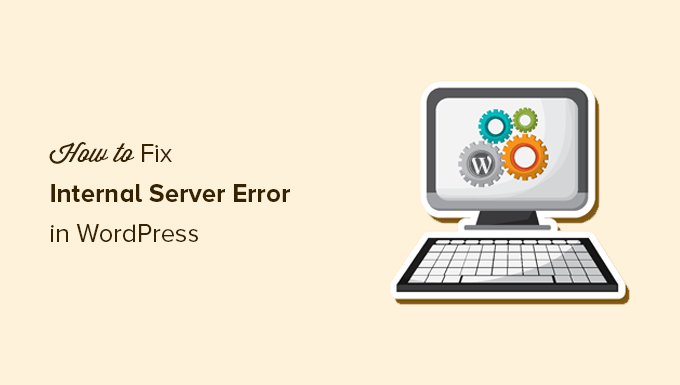
He aquí un breve resumen de los debates que abordaremos en este artículo:
- What Is the 500 Internal Server Error?
- What Causes the Internal Server Error in WordPress?
- Fixing the 500 Internal Server Error in WordPress
- Clear WordPress and Browser Cache
- Checking for Corrupt .htaccess File
- Increasing the PHP Memory Limit
- Deactivate All WordPress Plugins
- Switch to a Default WordPress Theme
- Re-Uploading Core Files
- Enable Debug Logs in WordPress
- Ask Your Hosting Provider
- Video Tutorial
¿Qué es el error 500 Internal Server Error?
El error 500 Internal Server Error es como una puerta cerrada sin llave. Sabes que algo va mal, pero no hay ninguna nota que explique qué ha pasado.
Este error no es sólo un problema de WordPress. Puede aparecer en cualquier sitio web cuando el servidor se encuentra con un problema que no sabe cómo resolver.
El “500” del mensaje es un código de estado HTTP. Si lo buscas, encontrarás una vaga definición:
“El código de respuesta 500 Internal Server Error indica que el servidor encontró una condición inesperada que le impidió cumplir con la solicitud”.
Eso no es muy útil, ¿verdad? Es la forma que tiene el servidor de decir: “Algo se ha roto, pero no estoy seguro de qué”.
El aspecto de este error depende de la configuración de su alojamiento y de su navegador. Aquí tienes un ejemplo de cómo aparece en un servidor Apache:
Si su sitio se ejecuta en Nginx, puede parecer un poco diferente. Y si Google Chrome no puede cargar una página de error adecuada, verás algo como esto:
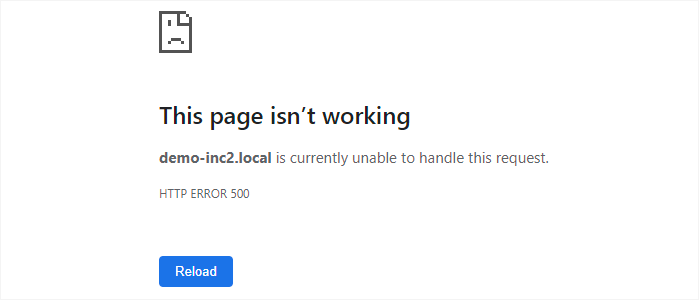
Para los principiantes, esto puede resultar abrumador. No hay ningún mensaje que explique qué ha fallado o cómo corregirlo.
Es como pedirle a un mecánico que te corrija el coche sin decirle qué se ha estropeado. Tendrán que marcar / comprobar distintas piezas hasta encontrar el problema / conflicto / incidencia.
Según nuestra experiencia, la mejor manera de corregirlo es hacerlo paso a paso. Te guiaremos a través de las causas y soluciones más comunes para que puedas hacer que tu sitio vuelva a funcionar.
Obtenga ayuda experta en cualquier momento con el soporte de WordPress bajo demanda.
Tratar con un error interno del servidor puede ser frustrante. Nuestro soporte de WordPress bajo demanda está aquí para ayudarle a corregir problemas técnicos de forma rápida y eficaz.
- Pago único para recibir soporte experto a la carta
- Plazos de entrega rápidos
- Disponible 24 horas al día, 7 días a la semana
¿Qué causa el error interno del servidor en WordPress?
El error interno del servidor en WordPress es como un puzzle al que le faltan piezas. Sabes que algo va mal, pero el mensaje de error no te dice exactamente dónde está el problema.
Según nuestra experiencia, el culpable más común es un archivo .htaccess corrupto. A veces, es un plugin o un tema que no funciona bien con tu configuración.
Otras veces, su sitio puede alcanzar el límite de memoria PHP, haciendo que WordPress se bloquee. Los archivos del núcleo corruptos también pueden desencadenar este error, dejándole bloqueado sin advertencia.
En algunos casos, el error solo aparece al intentar acceder al área de administración de WordPress, mientras que el resto del sitio funciona correctamente. Es como quedarse fuera de casa mientras los invitados pueden entrar por la puerta de atrás.
Lo que hace que este error sea complicado es que suele producirse antes de que WordPress pueda cargarse correctamente. Eso significa que el servidor no puede reunir suficientes detalles para explicar qué ha ido mal.
Si quieres saber cómo funciona WordPress entre bastidores, marca / comprueba nuestra guía sobre cómo funciona WordPress bajo el capó.
A continuación, vamos a diagnosticar los problemas para que su sitio vuelva a funcionar.
Corrección del error 500 Internal Server en WordPress
Antes de empezar a diagnosticar problemas, asegúrese de tener a mano una copia de seguridad completa de WordPress de su sitio web.
Si tiene acceso al área de administrador de WordPress, puede utilizar un plugin de copia de seguridad de WordPress para crear una copia de seguridad completa de su sitio web.
Recomendamos usar Duplicator para manejar esto. No solo te ayuda a hacer copias de seguridad rápidas de tu sitio web, sino que también puedes almacenar tus copias de seguridad en la nube y, lo que es más importante, puedes restaurar tu sitio web desde la copia de seguridad.
Por otro lado, si no tiene acceso al área de administrador de WordPress, puede crear manualmente una copia de seguridad de WordPress utilizando phpMyAdmin y un cliente FTP.
A continuación, puede seguir los siguientes pasos para diagnosticar y corregir el error interno del servidor en su sitio web.
Vaciar la caché de WordPress y del navegador
Los navegadores y sus plugins de caché de WordPress pueden a veces almacenar por error una copia en caché de una página de error.
La forma más fácil de corregirlo es vaciando primero la memoria caché del navegador.
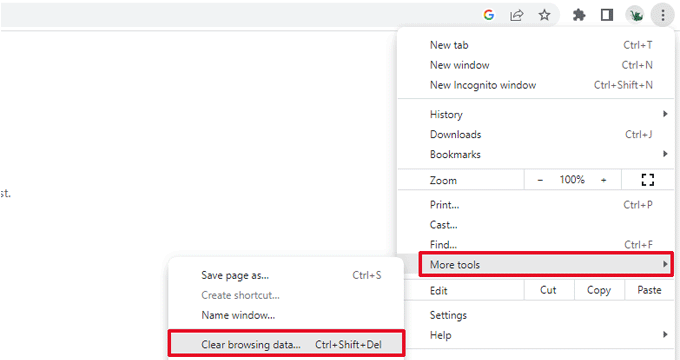
Después, si tiene acceso al área de administrador de WordPress de su sitio web, puede vaciar la caché de WordPress visitando la página de ajustes de su plugin de caché.
Para más detalles, consulte nuestro tutorial sobre cómo vaciar la caché de WordPress.
Comprobar si el archivo .htaccess está dañado
El archivo .htaccess es un archivo de configuración del servidor utilizado por WordPress para establecer las redirecciones.
Una de las causas más comunes de error interno del servidor es el archivo .htaccess corrupto.
La forma más fácil de establecer esto es simplemente visitando la página de Ajustes ” Enlaces permanentes en el área de administración de WordPress y luego haciendo clic en el botón “Guardar cambios” sin hacer ningún cambio.
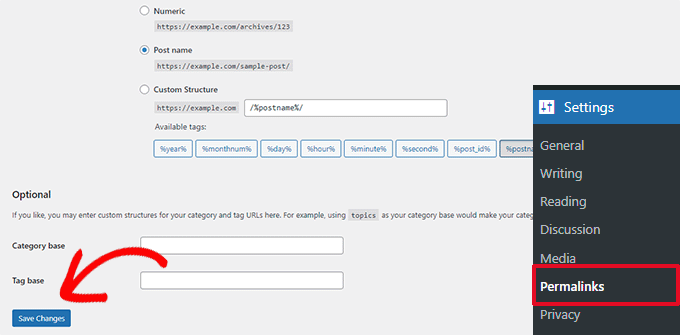
WordPress intentará actualizar su archivo .htaccess o generar uno nuevo. Ahora puede visitar su sitio web para comprobar si se ha resuelto el error interno del servidor.
Si aún puede ver el error, entonces necesita asegurarse de que WordPress pudo generar o escribir en el archivo .htaccess.
A veces, debido a los permisos de archivos y directorios, es posible que WordPress no haya podido crear o escribir en su archivo .htaccess.
Ahora puede intentar reemplazar el archivo .htaccess manualmente. En primer lugar, debe acceder a su sitio web mediante FTP o la aplicación Administrador de archivos del panel de control de su cuenta de alojamiento.
A continuación, debe renombrar suarchivo .htaccess principal a algo como .htaccess_old. Esto le permite mantener el archivo como una copia de seguridad, pero WordPress no lo reconocerá.
Para cambiar el nombre del archivo .htaccess, deberá acceder a su sitio mediante FTP o la aplicación Administrador de archivos del panel de control cPanel de su cuenta de alojamiento.
Una vez conectado, el archivo .htaccess estará ubicado en el mismo directorio donde verá carpetas como wp-content, wp-admin y wp-includes.
Simplemente haga clic con el botón derecho en el archivo .htaccess y cámbiele el nombre a .htaccess_old.
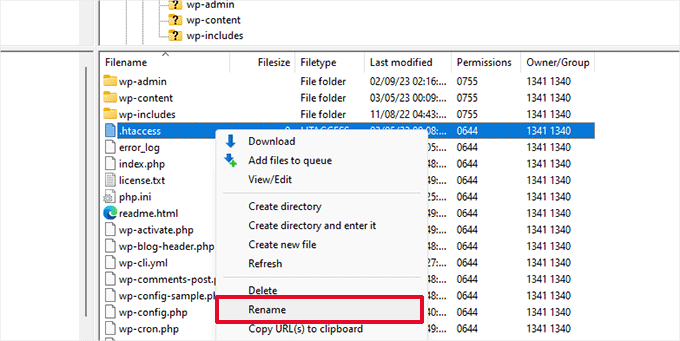
A continuación, debe crear un nuevo archivo .htaccess.
Dentro de la carpeta raíz de su sitio, haga clic con el botón derecho del ratón y seleccione la opción “Crear nuevo archivo” en su cliente FTP o aplicación de gestión de archivos.
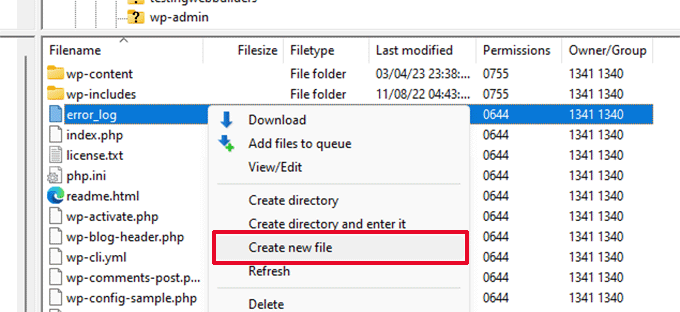
Nombre este nuevo archivo .htaccess y haga clic en “Aceptar” para guardarlo.
Ahora, este archivo .htaccess está actualmente vacío, y necesita añadirle reglas de reescritura por defecto de WordPress.
Sólo tienes que hacer clic con el botón derecho en el archivo y seleccionar “Ver/Editar” en tu cliente FTP o aplicación de gestión de archivos.
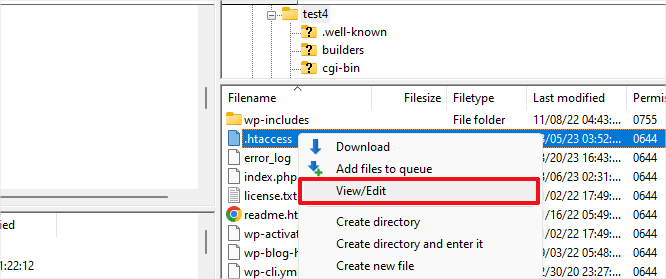
El archivo vacío se abrirá en un editor de texto plano como Notepad o TextEdit.
Ahora, tienes que copiar y pegar el siguiente código en su interior:
1 2 3 4 5 6 7 8 9 10 | # BEGIN WordPress<IfModule mod_rewrite.c>RewriteEngine OnRewriteBase /RewriteRule ^index.php$ - [L]RewriteCond %{REQUEST_FILENAME} !-fRewriteCond %{REQUEST_FILENAME} !-dRewriteRule . /index.php [L]</IfModule># END WordPress |
Este código es el conjunto de reglas por defecto utilizado por WordPress. No olvide guardar los cambios y volver a subir el archivo al servidor.
Ahora puede visitar su sitio web para comprobar si se ha resuelto el error interno del servidor.
Si es así, date una palmadita en la espalda porque has corregido el error interno del servidor.
Importante: Antes de continuar con otras cosas, asegúrese de ir a la página Ajustes ” Enlaces permanentes en el área de administrador de WordPress y haga clic en el botón Guardar sin realizar ningún cambio. Esto regenerará el archivo .htaccess con las reglas de reescritura adecuadas para garantizar que las páginas de entradas no devuelvan un error 404.
Si la solución de comprobar si el archivo .htaccess está corrupto no le ha funcionado, entonces tiene que seguir leyendo este artículo.
Aumentar el límite de memoria PHP
A veces, el error interno del servidor puede ocurrir si un script consume todo el límite de memoria PHP.
La forma más fácil de aumentar el límite de memoria PHP es editando el archivo wp-config.php. Tenga cuidado al hacer esto si usted es un principiante. Usted quiere seguir estas instrucciones cuidadosamente porque incluso pequeños errores en los archivos del núcleo de WordPress pueden romper su sitio.
Para empezar, sólo tiene que conectarse a su sitio web WordPress mediante un cliente FTP o la aplicación Administrador de archivos del panel de control de su cuenta de alojamiento.
Encontrarás el archivo wp-config.php dentro de la carpeta principal de tu sitio web. Haz clic con el botón derecho y selecciona “Descargar”. Esto te asegurará que tienes una copia de seguridad del archivo en caso de que algo vaya mal.
Cuando lo hayas guardado, puedes hacer clic con el botón derecho y seleccionar “Ver/Editar”.
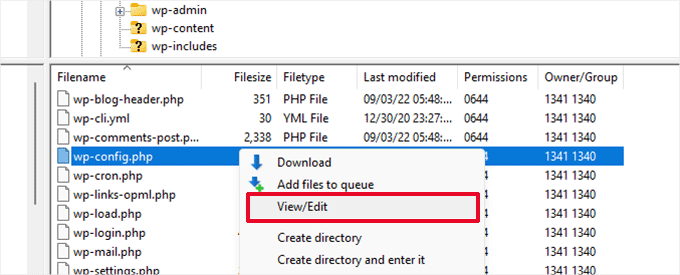
Dentro del archivo wp-config.php, debe añadir el siguiente código justo encima de la línea que dice: ‘¡Eso es todo, deje de editar! Feliz publicación’:
1 | define( 'WP_MEMORY_LIMIT', '256M' ); |
Para más detalles, consulte nuestro tutorial sobre cómo aumentar el límite de memoria PHP en WordPress.
Nota: Si 256M no resuelve el problema, intente aumentarlo a 512M.
Si ve el error interno del servidor solo cuando intenta acceder a su administrador de WordPress o subir una imagen en su wp-admin, entonces debe aumentar el límite de memoria siguiendo estos pasos:
- Crea un archivo de texto en blanco en tu ordenador y llámalo php.ini
- Pega este código: memory=256MB
- Guardar el archivo
- Súbelo a tu carpeta /wp-admin/ usando FTP
Si aumentar el límite de memoria te ha corregido el problema, entonces solo lo has hecho temporalmente. Todavía tienes que encontrar la causa que está agotando tu límite de memoria.
Podría tratarse de un plugin mal codificado o incluso de una función del tema. Le recomendamos encarecidamente que pida a su empresa de alojamiento web de WordPress que revise los registros del servidor para ayudarle a encontrar el diagnóstico exacto.
Si al aumentar el límite de memoria PHP no se ha corregido el problema, es necesario diagnosticar más problemas.
Desactivar todos los plugins de WordPress
Si ninguna de las soluciones anteriores le ha funcionado, lo más probable es que este error esté causado por un plugin específico instalado en su sitio web.
También es posible que se trate de una combinación de plugins que no funcionan bien entre sí.
Si puede acceder al área de administrador de WordPress de su sitio web, sólo tiene que ir a la página de plugins y desactivar todos los plugins de WordPress.
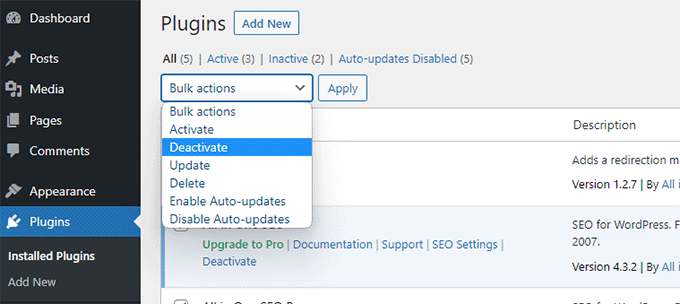
Sin embargo, si no se ha podido acceder al área de administrador de WordPress, se pueden desactivar todos los plugins de WordPress mediante FTP.
Sólo tienes que conectarte a tu sitio web WordPress mediante un cliente FTP o la aplicación de gestión de archivos del panel de control de tu cuenta de alojamiento.
Una vez conectado, vaya a la carpeta /wp-content/ y cambie el nombre de la carpeta plugins a plugins.deactivated.
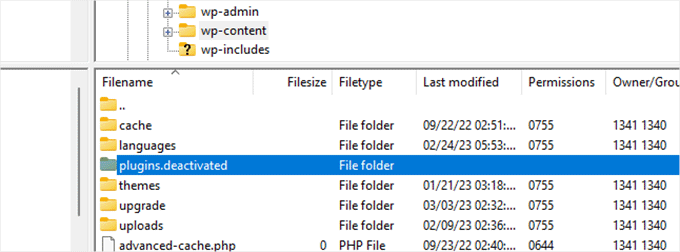
WordPress busca los plugins en la carpeta plugins. Si no encuentra la carpeta de plugins, desactivará automáticamente todos los plugins.
Ahora puede intentar visitar su sitio web para ver si esto ha resuelto el error interno del servidor en su sitio web.
Para restaurar todos tus plugins, puedes simplemente renombrar la carpeta ‘plugins.deactivated’ de nuevo a plugins.
Tus plugins se restaurarán, pero seguirán desactivados.
Ahora puede activar plugins individualmente y visitar su sitio web para averiguar qué plugin está causando el error interno del servidor.
Para más detalles, consulte nuestra guía sobre cómo desactivar todos los plugins de WordPress sin wp-admin.
Si la desactivación de todos los plugins no ha corregido el error interno del servidor en su sitio web, siga leyendo.
Cambiar a un tema predeterminado de WordPress
Una posible causa del error interno del servidor podría ser algún código de su tema de WordPress.
Para determinar si este es el caso, necesita cambiar su tema a un tema por defecto de WordPress.
Si tiene acceso al área de administrador de WordPress, vaya a la página Apariencia ” Temas. Si tienes un tema por defecto ya instalado, entonces puedes simplemente hacer clic en el botón Activar para cambiar el tema.
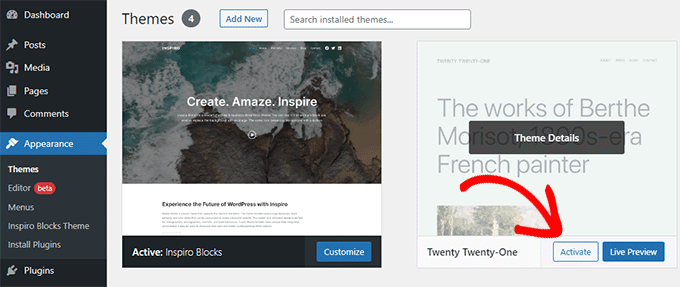
Si no tiene instalado un tema por defecto, puede hacer clic en el botón “Añadir nuevo” de la parte superior e instalar un tema por defecto (Twenty Twenty-Three, Twenty Twenty-Two, etc.).
Si no tienes acceso al área de administrador de WordPress, puedes cambiar a un tema por defecto.
Simplemente conéctese a su sitio web WordPress utilizando un cliente FTP y navegue hasta la carpeta /wp-content/.
Haz clic con el botón derecho para seleccionar la carpeta de temas y descárgala en tu ordenador como copia de seguridad.
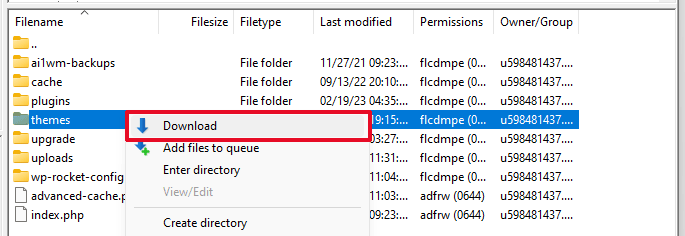
Lo siguiente que tienes que hacer es borrar la carpeta de temas de tu sitio web. Una vez que se borra, seguir adelante y crear una nueva carpeta de temas.
Su nueva carpeta de temas estará completamente vacía, lo que significa que no tiene ningún tema de WordPress instalado en este momento.
A continuación, debe visitar el directorio de temas de WordPress y descargar un tema de WordPress por defecto en su ordenador.
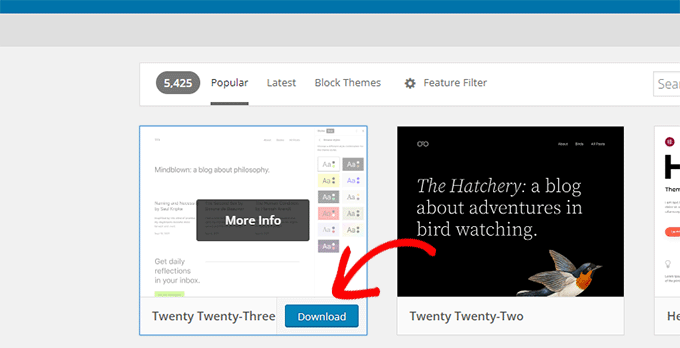
A continuación, su navegador descargará el tema como archivo zip en su ordenador.
Localice el archivo en su ordenador y descomprímalo. Los usuarios de Windows pueden descomprimir el archivo haciendo clic con el botón derecho y seleccionando “Extraer todo”. Los usuarios de Mac pueden hacer doble clic en el archivo zip para extraerlo.
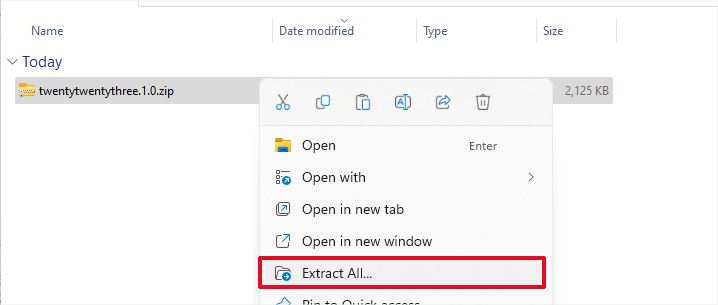
Ahora verá una carpeta que contiene su tema de WordPress.
Vuelva a su cliente FTP o al gestor de archivos y suba esta carpeta a la carpeta de temas vacía.
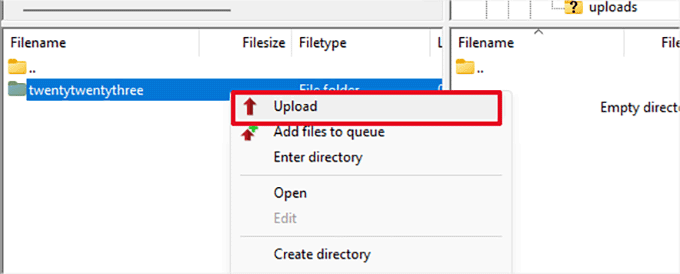
Una vez subido, WordPress empezará a utilizar automáticamente el tema por defecto.
Ahora puede visitar su sitio web para comprobar si se ha resuelto el error interno del servidor.
Si esto no funciona, puede volver a cargar sus temas de WordPress desde la copia de seguridad o volver al tema que estaba utilizando.
No se preocupe. Todavía hay algunas cosas más que puede hacer para corregir el error.
Volver a subir archivos del núcleo
Si las opciones del plugin y del tema no han corregido el error interno del servidor, vale la pena volver a cargar las carpetas /wp-admin/ y /wp-includes/ desde una nueva instalación de WordPress.
Esto NO eliminará ninguno de sus datos, pero puede solucionar el problema en caso de que algún archivo esté dañado.
En primer lugar, tendrás que visitar el sitio web WordPress.org y hacer clic en el botón “Descargar”.
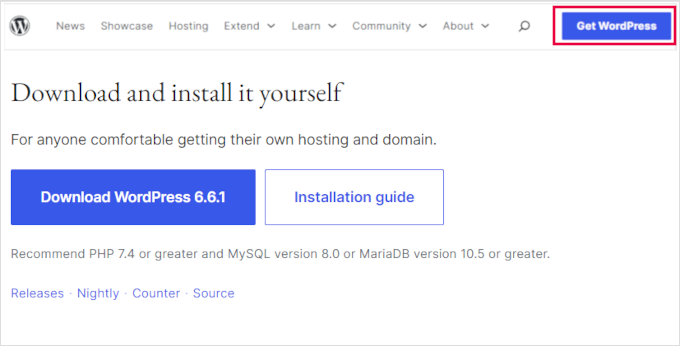
Esto descargará el archivo zip de WordPress en su ordenador.
Extraiga el archivo zip. Dentro de él, encontrará una carpeta wordpress.

A continuación, debe conectarse a su sitio web WordPress mediante un cliente FTP.
Una vez conectado, vaya a la carpeta raíz de su sitio web. Es la carpeta que contiene las carpetas wp-admin, wp-includes y wp-content.
En la columna de la izquierda, abra la carpeta WordPress de su ordenador.
Ahora tienes que seleccionar todos los archivos dentro de la carpeta de wordpress y subirlos a tu sitio web.
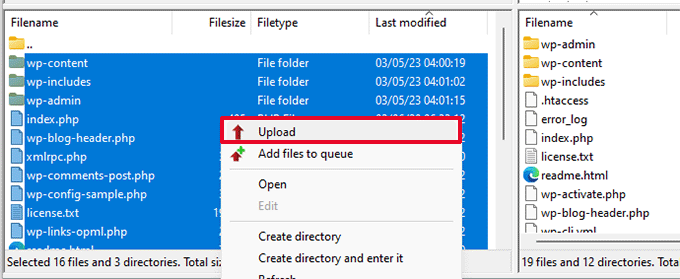
Tu cliente FTP transferirá ahora esas carpetas a tu servidor.
Le preguntará si desea sobrescribir los archivos. Seleccione “Sobrescribir”, luego seleccione “Utilizar siempre esta acción” y marque la casilla de verificación “Aplicar solo a la cola actual”.
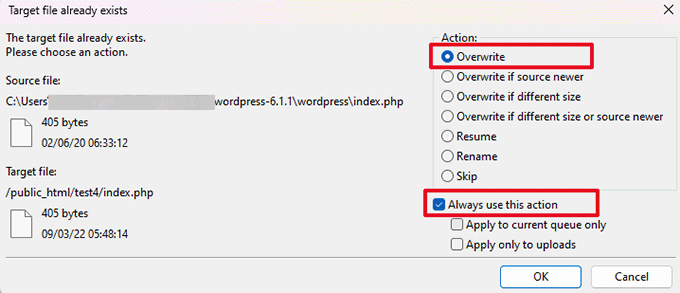
Su cliente FTP sustituirá sus archivos antiguos de WordPress por copias nuevas y actualizadas.
Si sus archivos de WordPress se corrompieron, este paso corregirá el error interno del servidor.
Activar los registros de depuración en WordPress
WordPress viene con un sistema incorporado para mantener los registros para depurar.
Puedes activarlo usando el plugin WP Debugging. Para más detalles, consulta nuestra guía sobre cómo instalar un plugin de WordPress.
Una vez activado, el plugin activará los registros de depuración en su sitio web WordPress.
Si no tiene acceso al área de administrador de su sitio web WordPress, puede activar la depuración añadiendo el siguiente código a su archivo wp-config.php:
1 2 | define( 'WP_DEBUG', true);define( 'WP_DEBUG_LOG', true); |
Una vez que haya activado los registros de depuración, puede verlos utilizando un cliente FTP y navegando hasta la carpeta /wp-content/.
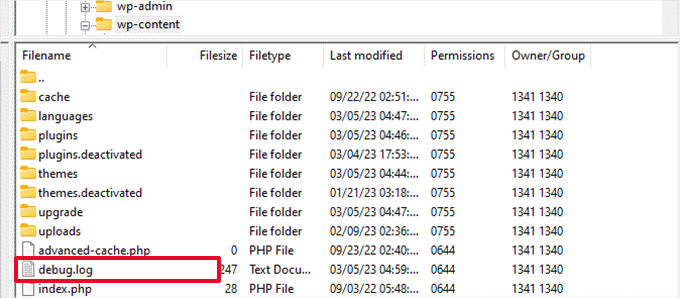
Puede abrir el archivo de registro de depuración en un editor de texto, y se le mostrará una lista de los errores y advertencias que se producen en su sitio web.
Algunos errores y advertencias pueden ser incidentes inofensivos que no necesitan corrección. Sin embargo, si ves un error interno del servidor en tu sitio web, entonces estos pueden indicarte la dirección correcta.
Pregunte a su proveedor de alojamiento
Si todos los métodos fallan a la hora de corregir el error interno del servidor en su sitio web, entonces es el momento de obtener algo más de ayuda.
Póngase en contacto con el equipo de soporte de su alojamiento web, y ellos podrán marcar / comprobar los registros del servidor y localizar la causa del error.
Si quieres seguir diagnosticando por tu cuenta, consulta nuestra guía definitiva para diagnosticar problemas en WordPress para principiantes.
Tutorial en vídeo
If you liked this article, then please subscribe to our YouTube Channel for WordPress video tutorials. You can also find us on Twitter and Facebook.




GEO D`ANJOS
It was necessary to update the plugin. Nothing more.
Very good this poster
Yasir
I encountered the following error :
Error 500 – Internal Server Error
An error was encountered while processing your request. Typically this is a temporary condition. Please contact the web site owner for further assistance.
So I talked to my hosting support and they suggest me the following procedure :
” Your cPanel account was set to use the PHP version 5.2, and it needed to be updated to the PHP 5.4 version. ”
Thanks ………. I worked for me ….
I am using inmotionhosting .
Venkateswarlu Santha
thanks so much… its working me
Sue
Thank you! Great advice even a non-techie volunteer can follow. The htaccess file was the main fix, but I could see by the logs that memory was creating a continual problem, so fixed that while I was at it.
Helpful Colin
I have not been in the situation where I have had to test my plugins by disabling them all yet, but if I had to test them all I would try this method to try and reduce the number of tests required after deactivating them all:
1. I would reactivate 50% of them. If the problem recurred I would know the problem plugin was in the reactivated group else it would be in the deactivated group.
2. If the problem was caused by the reactivated group I would deactivate 50% of them and retest else I would reactivate 50% of the other group that had not yet been reactivated and retest.
3. At this point I would know which group of 25% of all my plugins contained the faulty plugin and change the activation state of 50% of that group and retest.
4. At this point I would know which group of 12.5% of all my plugins contained the faulty plugin.
If I had 32 plugins the percentages above would divide them up very neatly into groups of 16, 8, 4, 2 and 1. It’s more likely that I would have to divide them into groups of unequal sizes but that doesn’t detract from the basic concept of reducing the number of tests to only 5 instead of 32.
If the problem proved to be with the only plugin I had not reactivated by this method then I would obviously carry out a sixth test with that plugin alone. If it proves that there is only a problem when it is activated along with other plugins then the scene would get complicated.
Warlley
That helped a lot! Thank you
mgarfath
it was w3 total cache plugin that caused error on my site, I renamed the cache folder but it didn’t changed any thing, then there were some other files that were written like w3 advanced cache.php something like that, I renamed EVERY FILE that had w3 cache or Even cache written on it worked but i accidentally deleted my .htaccess file, i had copied the content of the file safely, so i created new .htaccess file and uploaded it on the server, everything got fixed.
I hope this solution helps some one else who has this problem.
Than ks
Andrea S
thanks so much! I did, I was in panic, fortunately the first option (.htaccess) did the trick
anton
hello
i changed my theme to a tube video them named ” detube”
but after changing i am receiving a huge number of internal error 500 in Google webmaster( more then 800 error daily) and sometimes when i browsing my website don’t load and show me ” bandwidth limit resource” and also i receiving about 15 warning regarding to sitemap in Google webmaster
before changing theme i didn’t have any issues
can anyone help me? what can i do? i am losing my Google visitors
sarfraz khan
Thousand likes . .htaccess was problem and i just did it as shown in the video and the problem is solved
Gulshan Kumar
Internal Server Error mostly happens in Free Hosting. When I upgraded to premium, everything was on track.
Rich Finelli
This article has helped me at least twice in the last year! Thanks!
Joel Rodriguez
Deactivating Plugins solved my problem… Thanx a ton
Alberto Cardenas
Thanks mate, you saved my life hehehe, and gain a new follower, great site.
Serge
php.ini with memory=64Mb had solved my problem BIG THANKS!!!!
David
Very good
jakies
nop nothing of this soloutions solve the problem
toniak
many many thanks for this article
Nez
Thank you for these tips! It helped me a lot!
Imran Bughio
Bravo!
“Checking for Corrupt .htaccess File” This section helped me solve the issue, Thanks for the post
Sandile
Hi. Thank you for sharing this, I have recently experienced a 500 internal server error on my website but I re-uploaded wp-admin and wp-includes from fresh install, now everything is working in a good condition. Thank you.
Karan
The problem with my site is that sometimes it loads correctly and sometimes it shows 500 internal server error. Can you please tell me the reason for this?
Andrew P.
So, I have a really weird internal 500 error happening. My homepage loads up fine but whenever I click a link in the nav bar to go to another page the internal error pops up. I ran through this list of fixes and can’t seem to figure it out. Also my hosting provider doesn’t have a clue any ideas?
Sheff
Thank you for this. My dashboard crashed midway through a Wordfence Security update. I tried for over 3 hours to fix it but could not get into my dashboard. (500 http error in IE, white screen in firefox)
I was about to get my host to do a restore from last night and lose a day’s work until I found this page. I used FileZilla renamed the plugins folder on the serer to “plugins-frs” and was able to get into my dashboard with all 14 plugins deactivated. I then renamed the folder back to “plugins” and was able to activate them one at a time. They retained all of their settings, no problem.
I manually downloaded and uploaded the latest version of the Wordfence Security plugin that started my problems and activated the new version without issue.
I need to move to Newfoundland and become a cod fisherman before I go insane!
Sheff
Maher Aarag
What is a FTP?
And how to log in to my site using the FTP?
Do you mean log in to my Godaddy domain? or worldpress?
Prashant
FTP = File transfer protocol.
to login with ftp (in Godaddy Cpanel) you should go to your control panel and then go to FTP options and create new ftp by selecting ‘public_html’ directory and then login with any ftp clients like Filezilla.
host: ftp. yourdomain. com
username and password: as your specified while creating FTP user.
port: leave blank or 21.
Akpan Promise
FTP means file transfer protocol. It helps you transfer and edit files on your server.
FTP software for instance are Filezilla, CuteFTP.
Lisa Martin
Thanks you. I’ve used this technique multiple times on the same site. How can an .htcaccess file get corrupted? Is there anything that can be done to prevent it?
WPBeginner Support
You should check your .htaccess file permissions using an FTP client. These file permissions should be set to 644.
Admin
Lisa Martin
Thanks – I just thought to check here for your reply. The permission on the file is set to 644, but it keeps happening. It always works to rename the site and reload it, but often the client has to tell me his site is down before I know to go fix it for him. It looks like this is an issue in many WordPres forum threads as well.
Stephen Lee
Some plugins access the .htaccess and if there is a disruption to their function while doing so can introduce errors into the .htaccess coding.
Lisa Martin
Thank you. My solution for this recurring problem was to find all instances of “flush_rewrite_rules” and pass in “false,” so that the .htaccess file is not rewritten in the plugin code. https://codex.wordpress.org/Function_Reference/flush_rewrite_rules
I could not disable the plugin, since it is WooCommerce and that’s the whole basis for the site. This seems to be a pretty good fix for the situation I’m in.
Jon
Thank you for the tips, as I successfully recovered my site using these suggestions. A corrupt hta access file was the issue. Using FileZilla (highly recommended FTP Client) I was able to disable my plugin folder, then disable the hta access file.
Richard
What do I do when I can’t even enter the WP Admin without getting this error??
I can sign in fine and see those options, but the moment I want to enter the Admin panel, it gives me this error. I can’t even look up themes, customizer, etc because it involves the WP Admin menu.
What Do I Do?
Please Help
PS: I’ve never had issues with my site, but the WP Admin.
Hiago Ams
Great! Thanks so much, the best step by step available for most things I want is here
Danielle Olson
Thank you! This was so helpful. When I added _deactivate to my plugins folder, I got a different error message that had to do with one plugin in particular. So, I went in and added _deactivate to individual plugins until I found the one that was the problem.
msmith00
Just had an issue with this and thought I’d pass along my findings… looking in the root folder, a second .htaccess file had appeared overnight and created the 500 Internal error.
I simply removed the new .htaccess file (where it came from I don’t know), and all is back to normal.
Elliot K
This is the best WordPress help site around hands down! Love it so much! Guides are simple and everything always works for me first try. Thanks wpbeginner
Adil Adeel
This is a very informative and simple to understand tutorial for WP Beginners like me. I am using WordPress for last 5 years but as a blogger. Recently I had to install and look after couple of WordPress sites. Now 10 days back first WordPress site went down with 500 internal server error. I searched for the solution and landed on this page and did first step i-e renamed .htaccess file and problem was solved. Now again today the second site went down OMG !!!!! But again I visited this page to check for the solution.Now I have done all the steps explained on this page and nothing worked for me
OMG !!!!! But again I visited this page to check for the solution.Now I have done all the steps explained on this page and nothing worked for me  I have contacted the hosting provider and they are looking into problem for me. I will come back to share the solution once they rectify the problem. Thank you
I have contacted the hosting provider and they are looking into problem for me. I will come back to share the solution once they rectify the problem. Thank you
jofralogo
After trying everything (.htaccess, fresh install of wp-include/wp-admin, deactivate plugins…) I finally solve this problem doing this:
1) Create a new folder in your wp directory.
2) Move all files to this new directory.
3) Move them back to the original folder.
4) Ta-da!
I know it sounds stupid but it worked for me.
Shahin Shateri
This helped me a lot. fixed the issue.
JCP
Thanks for saving my ass guys, just got a new job and got thrown into fixing the website (despite not part of my job description) and wow, those pesky plugins! As deemyboy says: BACKUP that wp-content folder!!!!!!!
ed
maybe be a plugin
thankfulpj
Thank you so much for this guide! At least I was able to start somewhere while I wait for my hosting to check it. In my case, it was not any of the ones listed but a large error log on the home directory (it was 2GB) that did it. But when I re-uploaded the core files, I decided to delete it and it worked.
Paulo André Matta
Hi, I have tried all those sollutions above, but none worked for me. Im getting kind of desperated. Im new to WP.. I was changing some Settings (in the wp-admin link) and when I hit save, the 500 error came up. Idk what to do
Shaswat Shah
I uploaded the php.ini file to my /wp-admin/ folder. But now I am confused how can i know if 500 interneral server error is fixed or not ? because the error was coming simultaneously not all the time. Please help.
Patricia Mirasol
I know I got the internal service error because I was tinkering with my .htaccess file right before it occurred. Tried to log in using FTP clients (FileZilla and WinSCP) but I kept getting a connection error timeout. Just emailed my hosting provider. Hopefully, my provider will be able to help me with this.
Andrea Spila
Hi Silvia and thanks for this! I changed the permissions of the two files in wp-admin that were causing problems to 775 (from 664) and this solved then issue. And I don’t know why this happened too! It happened out of the blue. Mystery!
rajesh adulapuram
I tried all the above steps and finally when contacted My host provider iPage it was rectified. They told the problem is with file permissons and they rectified. This should have been my First step
Matt
I got back into my WP-Admin by renaming .htaccess but when I did settings>permalink>save as you recommend, I got locked out of admin again. Now renaming .htaccess does nothing. Any ideas?
Furkanicus
I’ve had this problem so many times and I feel comfortable sharing my advise on this as an 500 Error expert. Sometimes the problem was solved by changing the htaccess file, but it was a temporary solution. As it’s pointed out in the article, 500 service errror is mostly caused by PHP memory limit and unfortunately adding a php.ini file is not going to cut it. Most hosting companies set Php limit to 128MB, including Dreampress, and if you exceed that limit, your hosting provider will momentarily cut the connection to your website. My advise for you people who has this problem is this. Install P3 Plugin and designate the memory-hogging plugins. If they’re not essential, remove them. Also, changing your host provider to a boutique one instead of Bluehost or Hostgator will get your better customer service and higher product quality.
WPBeginner Staff
If you cannot find your .htaccess file, then you can always create a new blank file in a text editor. Name this file .htaccess and upload it to your website’s root directory using an FTP client.
Tobie! ®
i still have a problem with this. i cant find my .htaccess file, and i have been locked out of admin. the whole site can’t be viewed. please help me
Gaurav
.htaccess is hidden. When accessing your file make sure you can hidden file also
Michael Fuller
Use cPanel > File Manager to access files
Tobie! ®
i’ve tried all these, and it still doesnt work!! i cant find my .htaccess file and i cannot generate it because i’m locked out of admin, HELP PLEASE!!!
Chirag Patel
Change index.php permission to 644
Thomas
That did it for me after everything else didn’t work!
David Moore
Thank you, thank you. The index.php to 644 did the trick for me after all sorts of hassle.
Hasan Zaheer
Very helpful, but one more thing, mostly its due to w3 total cache plugin, if you have that you can rename cache plugin folder through FTP and then try, my site was fixed this way
jim
thx … clear w3 cache solve my problem